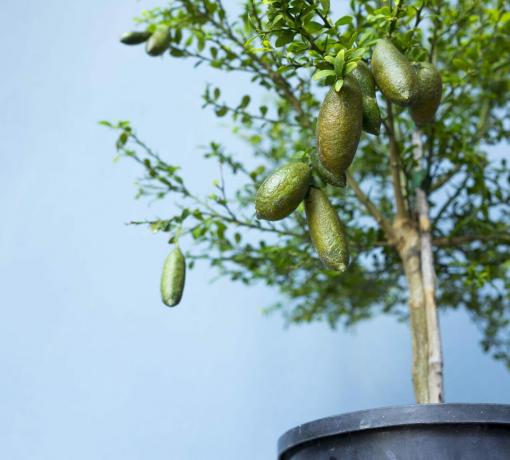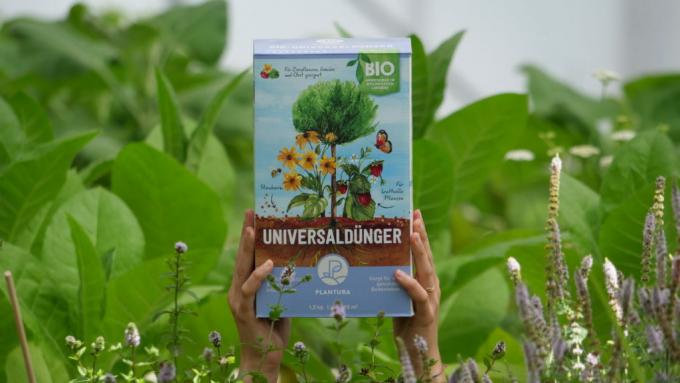The pulp gives the caviar lime its name. We show you what to consider when growing and caring for the caviar lime and what makes it so special.

Caviar from your own garden: You don't have to go to a fish farmer to do this. Because a special type of lime, the caviar lime (Microcitrus australasica), supplies so-called lime caviar. If you open the exotic fruit, you will find small balls inside that really look like caviar. To enjoy this specialty, you can grow the caviar lime yourself in your garden or on the balcony. In our article you will find out where the caviar lime comes from, what you need to consider when growing it and how to properly care for this special citrus plant.
contents
- Origin and properties of the caviar lime
- Caviar lime: Colorful variety
- Buying caviar lime: What to consider
- Cultivation and location of the caviar lime
- Caring for caviar lime: requirements and special features
- Using the caviar lime
The caviar lime is also called the Australian finger lime. This is because the fruits are elongated and thus resemble fingers. In English, the lime caviar is also called “Lime Pearls”. These pearls are a real luxury product: they are very expensive to buy and also not easy to get. It is all the more attractive to grow the caviar lime yourself so that you can harvest your own lime caviar.

Origin and properties of the caviar lime
The botanical name Microcitrus australasica reveals the origin of the caviar lime: Australia, more precisely the semi-arid dry zones of northern Australia. It is one of the few remaining wild forms of citrus plants and is a species of the genus Microcitrus in the diamond family (Rutaceae). The plants of the caviar lime are leafy with rather small leaves. When the plant is still young, the leaves are narrow and needle-shaped. As the plant ages, the leaves become larger and oval with rounded tips. This lime has a short but very pointed thorn in the leaf axes. The flowers are very small, four to five-fold, with four to eight segments in the ovary and bloom white with a pink center. The scent of the flowers and fruits is not quite as aromatic as with other types of lime, but the content of the fruits is all the more convincing. When the lime caviar bursts, it releases an intense and unique aroma.
Caviar lime: Colorful variety
The finger lime is available in many different varieties. Their skins and flesh are differently colored and the fruits can be elongated to spherical. Below is a selection of different types of caviar lime.

- ‚Polpa Gallia‘: The fruits of the finger lime 'Polpa Gialla' have a green skin and yellow pulp.
- ‚Virgata‘: The ripe fruits of this variety have a yellow-green skin. They grow round, but have the typical caviar-like flesh.
- ‚Byron Sunrise‘: The fruits of this variety of caviar lime have a maroon skin that turns almost black when fully ripe. The flesh is orange to red.
- ‚Durham's Emerald‘: The fruits of this finger lime are dark purple to black. The lime caviar is emerald green inside.
- ‚Jali Red‘: This type of caviar lime is characterized by its light red to pink flesh. The skin is dark green to brown.
- ‚Judy’s Everbearing‘: The ripe fruits of have a bright pink skin. The lime caviar is also pink.
- ‚Yellow‘: As the name suggests, the lime pearls in this variety are yellow. The skin of the fruit is green-yellow.
The variety of lime varieties is impressive. In addition to the caviar lime, there are many more special citrus fruits, which you can find out more about in our special article.
Buying caviar lime: What to consider
The first step to your own caviar lime is buying it. Caviar limes are still a rarity and are therefore quite expensive and may not be easy to find. However, you should be able to find what you are looking for in well-stocked and large tree nurseries and garden centers. There are also some specialist retailers on the Internet who specialize in citrus rarities and offer caviar limes for shipping. We have selected the following two providers for you because of their particularly large variety of caviar limes:

- Meine-orangerie.de: Only citrus and Mediterranean plants are offered for sale in the “Meine Orangerie” online shop. The range also includes a large selection of different finger lime varieties.
- zde: From citrus plants to pines and exotic fruit plants, Zitronenlust offers a wide variety of Mediterranean plants for sale. Here you will find a wide variety of caviar limes with care instructions.
But what should you look out for when buying caviar limes? With the naked eye, you shouldn't see any defects on the plant such as kinked leaves or damaged bark. In addition, the processing facility - most caviar lime trees are processed - should be of good quality. The choice of type is also decisive, because the types of caviar lime differ a lot in terms of appearance. You should also carefully check the health of the plant and make sure that the sapling is free from disease or pests.
When buying caviar limes, you should pay attention to the following factors:
- quality
- variety
- health status
Cultivation and location of the caviar lime
Basically, all citrus plants hardly differ in terms of cultivation and care. Once you've got the hang of one type of citrus, you can't go wrong with the others either. Detailed instructions on how to grow and how to Planting lime trees can be found in our special article. All citrus plants are not hardy and must therefore be grown in pots.

The finger lime is the wildest species that it prefers to be outside in the summer. However, it does not always have to be in full sun outdoors. The caviar lime is also satisfied with a partially shaded location in summer. But it should stand free and not have to fight with other plants for the little light. So that all sides of the plant get evenly sun and it grows evenly, you can twist your caviar lime every two months. In winter, the plant then moves to the winter garden or apartment. Here it should be bright and at temperatures of 3 to 15 ° C. The same applies to finger lime: the warmer it is, the lighter the special lime wants it to be.
Location requirements of the caviar lime at a glance:
- In summer outdoors
- Sunny to partially shaded location
- Inside in winter
- Winter temperatures: 3 to 15 ° C
Caring for caviar lime: requirements and special features
The care of finger lime does not differ significantly from that of other types of lime. Since it originally comes from semi-arid desert regions, it is reasonable to assume that its water requirement is lower than that of other types of lime. Even so, you should water your caviar lime regularly and never let it dry out. However, the exotic lime is very sensitive to waterlogging. So be sure to avoid these. During the main growing season, the caviar lime can be fortified with a special citrus fertilizer once a week. As an alternative to citrus fertilizer, an organic fertilizer can also be used.

Our Plantura organic universal fertilizer Made mainly of plant-based raw materials and with an organic long-term effect, your caviar lime is optimally supplied with all the important nutrients. In winter you can reduce the fertilization significantly or even stop it completely. Regular pruning is not necessary for finger lime, but dead and diseased parts of the plant should be removed. A pruning is also advisable if the plant is growing very unevenly. However, this should definitely be done during hibernation. The caviar lime should be repotted every two years.
An overview of the care measures for the caviar lime:
- Keep evenly moist
- Avoid waterlogging at all costs
- Fertilize with citrus fertilizer once a week in summer
- Cut if necessary
- Repot every two years
Using the caviar lime
The lime pearls of the caviar lime can be enjoyed raw and pure. But they are also ideal as a topping on various dishes, for decorating or as an optical eye-catcher and aromatic refinement in drinks. Lime caviar goes particularly well with fish dishes or as a topping on sushi. But it can also be mixed as a fruity component in salads. The pearls are particularly effective in drinks: Put a few pearls in a glass of prosecco or champagne or mix the lime caviar in a wide variety of cocktails. The fruity globules also look good in desserts, for example in ice cream or on cakes.

Are you even more interested in interesting and unusual types of lime? You can find out more about the in our special article Special features of the kaffir lime.
